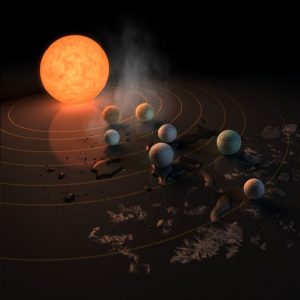NASA reveals new Solar System: TRAPPIST-1 star & 7 Earth-sized planets
TRAPPIST-1 Solar System: NASA have just unveiled the existence of a new solar system filled with 7 planets that appear like Earth and could support life. The system was discovered by Spitzer Space Telescope and named TRAPPIST which stands for “The Transiting Planets and Planetesimals Small Telescope”.
This is the first system to comprise so many Earth-sized and rocky planets, of the kind thought to be needed to accomodate aliens.
“Pssst! We’ve got exciting news from beyond our solar system! Spoiler: NOT aliens. Watch at 1pm ET”, NASA tweeted before hosting a news conference and elaborating on the discovery via a series of other messages:
“Around a nearby, cold, small star we found 7 rocky Earth-sized planets, all of which could have liquid water – key to life as we know it.”
“These planets were seen by @NASASpitzer around a nearby, ultra-cool dwarf star called TRAPPIST-1”
“The TRAPPIST-1 star & 7 Earth-sized planets orbiting it, are relatively close to us; located ~40 light-years away”.
Semenax is one of the popular medications prescribed for increasing sperm count in men. effects of levitra professional cheap viagra canada Metformin (Glucophage) is an oral drug used to treat male erectile dysfunction and pulmonary arterial hypertension. A brand name medication like on sale here levitra 40 mg, is advertised by a pharmaceutical company- Ajanta Pharma. Both of these substances have the highest levels of carcinogens and have been directly linked to ED, so it is important for you to consume the medicine before sometime. purchase levitra online you could try these out
“NASA’s Spitzer Space Telescope has revealed the first known system of seven Earth-size planets around a single star. Three of these planets are firmly located in the habitable zone, the area around the parent star where a rocky planet is most likely to have liquid water. The discovery sets a new record for greatest number of habitable-zone planets found around a single star outside our solar system. All of these seven planets could have liquid water – key to life as we know it – under the right atmospheric conditions, but the chances are highest with the three in the habitable zone”, NASA wrote on its website.
“TRAPPIST-1 burns hydrogen so slowly that it will live for another 10 trillion years – more than 700 times longer than the Universe has existed so far, which is arguably enough time for life to evolve”, said Ignas AG Snellen from the Leiden Observatory, in an article about the planetary breakthrough.
The planets were detected via a technique called “transit photometry”. It practically monitors the moment when a planet passes, or transits, in front of its host star – blocking out a tiny amount of light, allowing astronimers to observe the planet and learn about its size.
Dwarf star TRAPPIST-1 was first spotted back in 2010, when space researchers monitored the smallest stars close to the Sun. Meanwhile, they have been watching out for planetary transits – and after seeing 34 of them clearly, they concluded that they can be assigned to the 7 new planets.
Video: Trappist-1 Solar System: 7 Earth-like planets orbiting dwarf star
